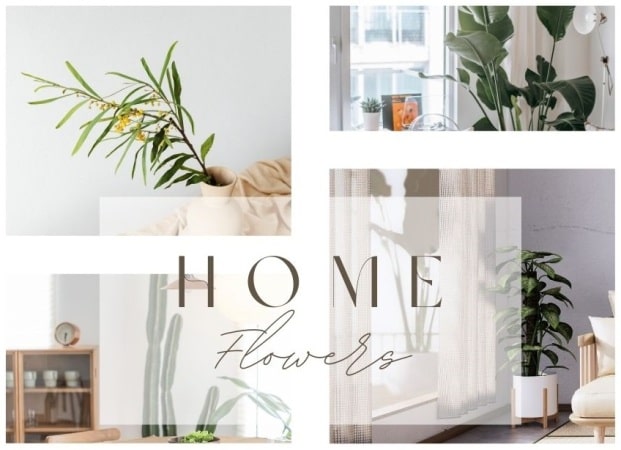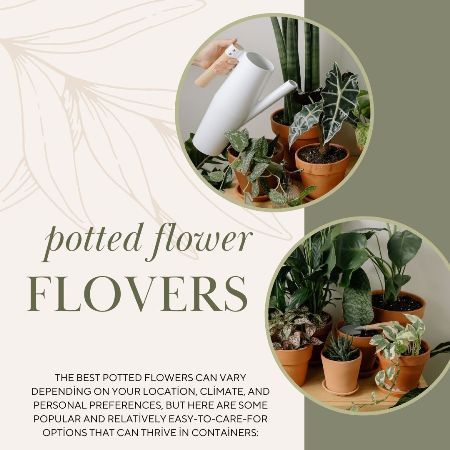The best potted flowers can vary depending on your location, climate, and personal preferences, but here are some popular and relatively easy-to-care-for options that can thrive in containers:
Geraniums (Pelargonium): These are known for their vibrant blooms and are quite hardy. They come in a variety of colors and are great for both indoor and outdoor pots.
Petunias: Petunias are excellent for adding bright and cheerful colors to your garden or balcony. They come in various colors and are known for their prolific flowering.
Marigolds (Tagetes): Marigolds are known for their pest-repelling properties and their sunny, yellow or orange blooms. They’re easy to grow and can thrive in pots.
Lavender: Lavender not only has beautiful purple flowers but also a delightful fragrance. It’s a great choice for containers, especially if you want to enjoy the scent.
Snapdragons (Antirrhinum): These flowers come in a range of colors and resemble the face of a dragon when you squeeze them. They’re often used to add height to container gardens.
Daffodils (Narcissus): For spring blooms, daffodils are a great choice. Plant them in the fall for beautiful yellow, white, or orange flowers in the spring.

Pansies: Pansies are cool-weather flowers that come in a variety of colors and have charming, “face-like” markings on their petals. They’re great for fall and spring containers.
Salvia: Salvia is a low-maintenance, drought-tolerant plant that produces spikes of colorful flowers. They come in various shades, including red, purple, and blue.
Begonias: Begonias are available in a variety of sizes and colors and can thrive in shaded or partially shaded areas, making them versatile for different growing conditions.
Fuchsia: Fuchsia plants are known for their pendulous, tubular flowers that can add an exotic touch to your garden. They prefer partial shade and moist conditions.
Calibrachoa (Million Bells): These small, petunia-like flowers come in various colors and are prolific bloomers, making them a great choice for hanging baskets or containers.
Nasturtium: Nasturtiums are not only beautiful with their orange, red, or yellow blooms, but they are also edible, with both the flowers and leaves being used in salads.
When selecting potted flowers, consider the specific growing conditions of your location (e.g., sunlight, temperature, and humidity) and choose flowers that are well-suited to those conditions. Also, be sure to provide proper care, including the right soil, watering, and fertilizing, to ensure your potted flowers thrive.
How to care for pots at home?
Caring for potted plants at home is essential to ensure they thrive and remain healthy. Here are some general guidelines for pot plant care:

1. Choose the Right Container:
- Select pots or containers that have drainage holes at the bottom to prevent water from accumulating and causing root rot. Proper drainage is crucial for the health of your plants.
2. Choose the Right Soil:
- Use a high-quality potting mix that is suitable for the specific type of plant you’re growing. Different plants have different soil requirements.
3. Watering:
- Monitor the moisture level of the soil. Stick your finger into the soil about an inch deep; if it feels dry at that depth, it’s time to water. Avoid overwatering, as it can lead to root rot. Water thoroughly when you do water, ensuring the water reaches the root zone.
4. Sunlight:
- Place your potted plants in an appropriate location based on their sunlight requirements. Some plants thrive in full sun, while others prefer partial or full shade. Be aware of your plant’s specific needs.
5. Fertilization:
- Fertilize your potted plants regularly but in moderation. Use a balanced, slow-release fertilizer or a liquid fertilizer diluted to half strength. Follow the recommended feeding schedule for your particular plants.
6. Pruning and Deadheading:
- Prune and deadhead your plants as needed to encourage healthy growth and more blooms. Remove dead or diseased leaves and spent flowers to promote new growth.
7. Pest and Disease Control:
- Regularly inspect your plants for signs of pests or diseases. If you notice any issues, take appropriate action, which may include using natural remedies, such as neem oil or insecticidal soap, or, in severe cases, using chemical treatments.
8. Repotting:
- As your plants grow, they may become root-bound. Repot them into slightly larger containers when this happens. This provides them with more space for their roots to grow and access nutrients.
9. Support and Staking:
- Some plants, especially tall or vining ones, may need support or staking to prevent them from falling over or breaking.
10. Seasonal Care:
- Some plants are sensitive to temperature changes. Bring potted plants indoors during winter if they can’t tolerate frost, and consider moving them to a shadier spot during hot summer months if necessary.
11. Mulching:
- Applying a layer of mulch on the soil surface can help retain moisture, regulate soil temperature, and reduce weed growth.
12. Monitoring and Adjusting:
- Keep a close eye on your potted plants and make adjustments as needed. Plants may show signs of stress or nutrient deficiencies, so it’s important to address these issues promptly.
Each type of plant may have specific care requirements, so it’s a good idea to research the specific needs of the plants you’re growing. By providing proper care and attention to your potted plants, you can enjoy healthy, vibrant, and thriving greenery in your home.
Top 5 potted flowers for home
Here are five popular potted flowers that are well-suited for growing at home:
African Violet (Saintpaulia): African violets are known for their small, delicate, and colorful blooms. They are perfect for indoor environments, as they thrive in indirect light. Keep the soil consistently moist but avoid watering the leaves to prevent fungal issues.
Orchids: Orchids are elegant and come in a wide range of colors and patterns. They are often grown as indoor potted plants. They prefer bright, indirect light and a well-draining orchid potting mix. Orchids require specific care, but with the right conditions, they can be long-lasting and rewarding.
Peace Lily (Spathiphyllum): Peace lilies are popular houseplants with attractive white, spoon-shaped flowers. They are excellent air purifiers and can thrive in low to moderate light. Keep the soil evenly moist but not waterlogged.
Moth Orchid (Phalaenopsis): Moth orchids are one of the most common and easy-to-care-for orchid varieties. They have striking, long-lasting flowers and can thrive in indoor conditions with bright, indirect light. They prefer to dry out slightly between waterings.
Snake Plant (Sansevieria): While not a traditional flowering plant, snake plants are great for adding greenery to your home. They are extremely low-maintenance, tolerant of low light, and can thrive on infrequent watering.
These potted flowers and plants are known for their beauty and adaptability to indoor environments. When caring for them, pay attention to specific care instructions for each type of plant to ensure they thrive and provide a welcoming atmosphere in your home.
